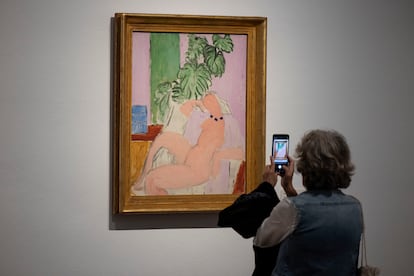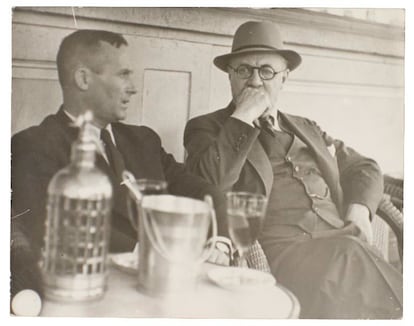You reach the end of the route MiróMatisse, beyond imageswith an overdose of energy, color and beauty, a shot of renewed vigor and optimism. And then, in the last room, the blue explodes: Painting (the white glove), by Joan Miró, and View of Notre-Dame, by Henri Matisse, hand in hand, side by side, their wonderful hues conversing on the white wall of the Miró Foundation in Barcelona. “Two very different blues that dialogue so well, two ways of understanding art in communication with each other,” exclaims the center’s director, Marko Daniel, enthusiastically. “We see the world differently thanks to the way Miró and Matisse saw and represented it; “Contemporary painters still draw from the immense source of innovation that these two artists are.”
The great exhibition on the relationship between the two creators, organized and produced by Miró with the Musée Matisse in Nice, now arrives in Barcelona (until February 9, 2025) after its success at the French museum and with the added bonus of luminous Sert building in which the exhibition reaches a new dimension. The original idea, as its curator, Rémi Labrusse, emphasized today at the inauguration, was not to show the influence of one artist on another, either of the elder on the younger (Matisse, in 1869, was 23 years older than Miró, of 1893) or the opposite, but the “reciprocal stimuli” that were provided between them. “Everyone made their own way. The challenge was to teach works that are not similar but that give a sensation of communication; “beyond the notion of influence or imitation, to show the shared energy of artists who, each from their own perspective, questioned the pictorial tradition and went very far in the deconstruction and reconstruction of art.” Labrusse has highlighted “vitalism” as the most important word regarding both painters. “His will to produce a vital energy beyond images.”
The exhibition, sponsored by the BBVA Foundation, chronologically follows the careers of Miró and Matisse, who, despite their apparently different pictorial conceptions (surrealism and fauvism), admired each other, and were good friends after Pierre Matisse, the son of the painter, he became Miró’s dealer in 1934 (and was instrumental in the dissemination of his work in the United States). The journey through the life and work of both painters allows us to contemplate sensational works – the visit is a first-rate aesthetic experience – with the paintings and drawings of Matisse and Miró sparkling between them in a happy electrifying dance of colors and motifs. On the tour, with 160 works including documentation, two large nudes of both, standing nude (1918), by Miró, and Decorative figure on ornamental background (1925-26), by Matisse; Still life, red interior of Venice (1946), from French, and Birds in space (1959), from Catalan; the hypnotic Odalisque with red chest, by Matisse, which contrasts with its sensuality with the innocence of Margaret reading by the same painter; the beautiful goldfinch in its cage North-South (1917) by Miró…
From the beginning, when the exhibition points out the Mediterranean experience of both (Matisse settled in Collioure, where he invented Fauvism with Derain in 1905), works can be compared (55 matisses y 53 miros): landscapes like Harvest in August (1911), from French, and Cambrils, the beach (1917), from Catalan, or still lifes like The pumpkinsby Matisse (1915-16) Still life (carbide light), from 1922-23, by Miró. The relationship is thoroughly documented: Miró had heard of Matisse even before his first trip to Paris in 1920, through Francophile painters such as Joaquim Sunyer. saw his first matisse, Still life with pumpkinin 1917, at the French art exhibition in Barcelona. At the exhibition of avant-garde French art in the Catalan capital at the Galeries Dalmau in 1920, they exhibited together (you can see the catalog in a display case). A photo already shows the two painters sitting talking on the cafe terrace The two Margots in 1936.

The exhibition, with works from museums such as the MoMA in New York, the Reina Sofía, or the Musée de Grenoble, in addition to contributions from the families of both artists, collects revealing phrases from the painters about each other’s art. Matisse is impressed by Miró’s work, “including his violence,” and considers him a “real painter.” Miró wants the Fauvism of Matisse’s paintings, “but more brutal.” They apparently contrast Matisse’s “decorative” aesthetic and Miró’s program of “murder of painting” to give way to his universe of signs and symbols. But, it is pointed out, they are “two sides of the same coin”, options, as Labrusse has said, of two great modernists in the same process of renewal of art with their explorations and intuitions, which led them (as the subtitle of the exhibition) to transcend traditional images.
A fundamental moment in the relationship between the two painters is when, in the midst of a crisis of creativity in the 1930s, Matisse asks his son for two paintings by Miró to study, and finds in them a source of inspiration to “restart” his artistic approach. This specific “reverse influence”, of the young artist on the older one, has led to Miró’s name being placed before Matisse’s in the title of the exhibition.
Marko Daniel has emphasized that we are dealing with two of the greatest artists of the 20th century whose relationship has never been explored in this depth. He highlighted the unprecedented dialogue between the master creations of the exhibition, pointing out that some rooms “force you to sit down to endure the shock of the juxtaposition of works.” Véronique Dupas, curatorial assistant, explained that the origin of the exhibition lies in the investigation of the correspondence of Pierre Matisse, a key figure in the meeting between her father and Miró.


